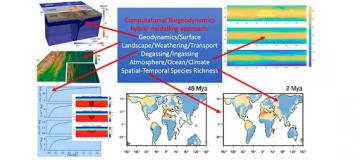
Influence of plate tectonics on life evolution and biodiversity: biogeodynamical modeling
Speaker: Dr. Taras Gerya - Institute of Geophysics, Department of Earth Sciences – ETH-Zurich
04.05.2021
Tuesday, 4th May 2021 – 4:30 PM
Webinar “Live” seminar on-line at Zoom link: https://unipd.zoom.us/j/82978693795?pwd=TmlBSDBVRFVNL3NwTUpGSW8rWFdpQT09
Geodynamic evolution of the mantle and lithosphere on Earth is intrinsically linked to the evolution of its atmosphere, oceans, landscape and life and we would like to understand these interactions better trough the emerging transdisciplinary field of biogeodynamics. The solid Earth went through multiple tectono-magmatic styles during its geological history. The influences of any global tectono-magmatic style are at least twofold. Firstly, life is sustained by a critical set of elements contained within rock, ocean and atmosphere reservoirs and cycled between Earth’s surface and interior via various tectonic, magmatic and surface processes. Second, tectonic processes such as the redistribution of continents, growth of mountain ranges, formation of land bridges, and opening and closing of oceans provide environmental pressures that isolate and stimulate populations to adapt and evolve. Modern-style plate tectonics that established shortly before the Cambrian explosion is often viewed as a strong promoter of the biological evolution. It exerts continuous moderate environmental pressures that drive evolution and stimulates populations to adapt and evolve without being capable of extinguishing all life. Importantly, timescales of biological evolution of complex life estimated on the basis of the analysis of phylogenies and/or fossils are rather long and comparable to geodynamic timescales. This timescale similarity creates a natural possibility for investigating coupling of lithospheric and mantle processes with life evolution by using novel hybrid bio-geodynamical numerical models that are currently emerging.





